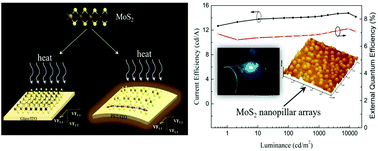Our official English website, www.x-mol.net, welcomes your
feedback! (Note: you will need to create a separate account there.)
High-performance flexible inverted organic light-emitting diodes by exploiting MoS2 nanopillar arrays as electron-injecting and light-coupling layers
Nanoscale ( IF 5.8 ) Pub Date : 2017-08-31 00:00:00 , DOI: 10.1039/c7nr03920d Kunping Guo 1, 2, 3, 4, 5 , Changfeng Si 2, 3, 4, 5, 6 , Ceng Han 4, 7, 8, 9 , Saihu Pan 1, 2, 3, 4, 5 , Guo Chen 2, 3, 4, 5, 6 , Yanqiong Zheng 2, 3, 4, 5, 6 , Wenqing Zhu 2, 3, 4, 5, 6 , Jianhua Zhang 1, 2, 3, 4, 5 , Chang Sun 10, 11, 12, 13 , Bin Wei 1, 2, 3, 4, 5
Nanoscale ( IF 5.8 ) Pub Date : 2017-08-31 00:00:00 , DOI: 10.1039/c7nr03920d Kunping Guo 1, 2, 3, 4, 5 , Changfeng Si 2, 3, 4, 5, 6 , Ceng Han 4, 7, 8, 9 , Saihu Pan 1, 2, 3, 4, 5 , Guo Chen 2, 3, 4, 5, 6 , Yanqiong Zheng 2, 3, 4, 5, 6 , Wenqing Zhu 2, 3, 4, 5, 6 , Jianhua Zhang 1, 2, 3, 4, 5 , Chang Sun 10, 11, 12, 13 , Bin Wei 1, 2, 3, 4, 5
Affiliation

|
Inverted organic light-emitting diodes (IOLEDs) on plastic substrates have great potential application in flexible active-matrix displays. High energy consumption, instability and poor electron injection are key issues limiting the commercialization of flexible IOLEDs. Here, we have systematically investigated the electrooptical properties of molybdenum disulfide (MoS2) and applied it in developing highly efficient and stable blue fluorescent IOLEDs. We have demonstrated that MoS2-based IOLEDs can significantly improve electron-injecting capacity. For the MoS2-based device on plastic substrates, we have achieved a very high external quantum efficiency of 7.3% at the luminance of 9141 cd m−2, which is the highest among the flexible blue fluorescent IOLEDs reported. Also, an approximately 1.8-fold improvement in power efficiency was obtained compared to glass-based IOLEDs. We attributed the enhanced performance of flexible IOLEDs to MoS2 nanopillar arrays due to their light extraction effect. The van der Waals force played an important role in the formation of MoS2 nanopillar arrays by thermal evaporation. Notably, MoS2-based flexible IOLEDs exhibit an intriguing efficiency roll-up, that is, the current efficiency increases slightly from 14.0 to 14.6 cd A−1 with the luminance increasing from 100 to 5000 cd m−2. In addition, we observed that the initial brightness of 500 cd m−2 can be maintained at 97% after bending for 500 cycles, demonstrating the excellent mechanical stability of flexible IOLEDs. Furthermore, we have successfully fabricated a transparent, flexible IOLED with low efficiency roll-off at high current density.
中文翻译:

利用MoS 2纳米柱阵列作为电子注入和光耦合层的高性能柔性倒置有机发光二极管
塑料基板上的反向有机发光二极管(IOLED)在柔性有源矩阵显示器中具有巨大的潜在应用。高能耗,不稳定和电子注入不良是限制柔性IOLED商业化的关键问题。在这里,我们已经系统地研究了二硫化钼(MoS 2)的电光学性质,并将其应用于开发高效且稳定的蓝色荧光IOLED。我们已经证明基于MoS 2的IOLED可以显着提高电子注入能力。对于塑料衬底上基于MoS 2的器件,我们在9141 cd m -2的亮度下实现了7.3%的非常高的外部量子效率,是所报道的柔性蓝色荧光IOLED中最高的。而且,与基于玻璃的IOLED相比,功率效率提高了约1.8倍。由于归因于它们的光提取作用,我们将柔性IOLED的增强性能归因于MoS 2纳米柱阵列。范德华力在通过热蒸发形成MoS 2纳米柱阵列中起着重要作用。值得注意的是,基于MoS 2的柔性IOLED表现出令人感兴趣的效率汇总,即电流效率从14.0 cd cd A -1稍微增加,而亮度从100 cd m -2增加到5000 cd m -2。另外,我们观察到初始亮度为500 cd m -2弯曲500次后,可将其保持在97%,这证明了柔性IOLED的出色机械稳定性。此外,我们已经成功地制造出了透明,柔性的IOLED,在高电流密度下具有低效率滚降。
更新日期:2017-09-22
中文翻译:

利用MoS 2纳米柱阵列作为电子注入和光耦合层的高性能柔性倒置有机发光二极管
塑料基板上的反向有机发光二极管(IOLED)在柔性有源矩阵显示器中具有巨大的潜在应用。高能耗,不稳定和电子注入不良是限制柔性IOLED商业化的关键问题。在这里,我们已经系统地研究了二硫化钼(MoS 2)的电光学性质,并将其应用于开发高效且稳定的蓝色荧光IOLED。我们已经证明基于MoS 2的IOLED可以显着提高电子注入能力。对于塑料衬底上基于MoS 2的器件,我们在9141 cd m -2的亮度下实现了7.3%的非常高的外部量子效率,是所报道的柔性蓝色荧光IOLED中最高的。而且,与基于玻璃的IOLED相比,功率效率提高了约1.8倍。由于归因于它们的光提取作用,我们将柔性IOLED的增强性能归因于MoS 2纳米柱阵列。范德华力在通过热蒸发形成MoS 2纳米柱阵列中起着重要作用。值得注意的是,基于MoS 2的柔性IOLED表现出令人感兴趣的效率汇总,即电流效率从14.0 cd cd A -1稍微增加,而亮度从100 cd m -2增加到5000 cd m -2。另外,我们观察到初始亮度为500 cd m -2弯曲500次后,可将其保持在97%,这证明了柔性IOLED的出色机械稳定性。此外,我们已经成功地制造出了透明,柔性的IOLED,在高电流密度下具有低效率滚降。











































 京公网安备 11010802027423号
京公网安备 11010802027423号